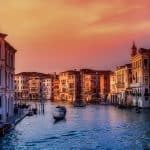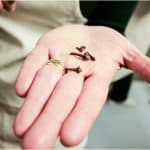Dazzling rather than drab and steeped in salacious history, the mosaics in Ravenna are some of the best mosaics in the world. Here’s an inside guide to the former capital of the Western Roman Empire.
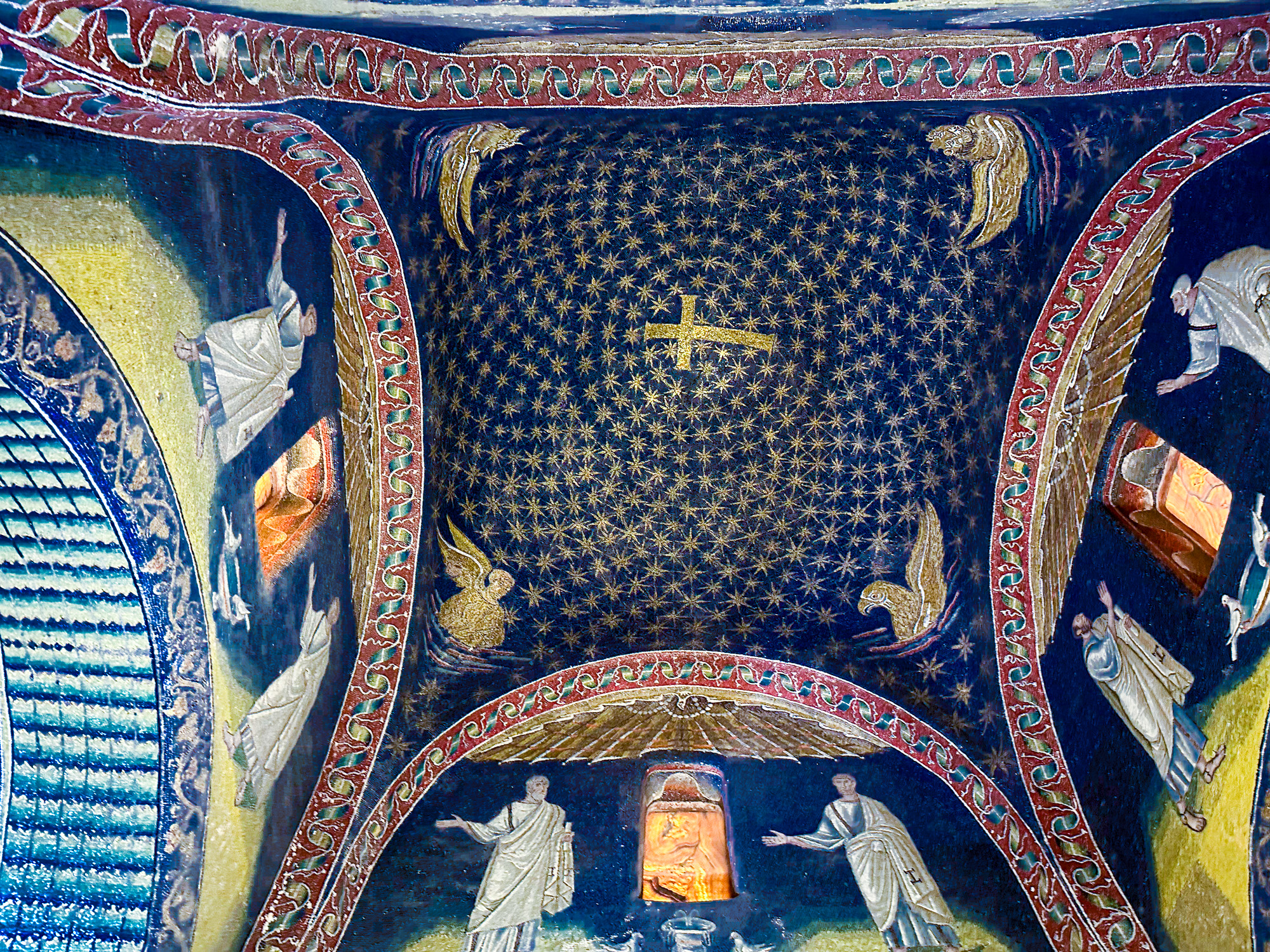
Why Mosaics Matter in Ravenna
My friends and family like to tease me about how much I love the colour blue. Midnight blue, royal blue, turquoise blue and cornflower blue. All bring me pleasure, with links to the soaring sky or the roll of the ocean, the scent of freedom and the chance to travel the world.
So imagine, if you will, my joy on discovering the mosaics of Ravenna. Say thee farewell to dusty drab cobblers of stone; Ravenna’s mosaics bathe in bright, brilliant colours. They soar across ceilings and glitter down from walls. The workshops serve blue glass pizzas, yes pizzas, sourced especially from Venice, which you can hold within your hands and clip (or smash) into pieces to make a mosaic of your own.
It was, in short, a revelation. And perhaps it shouldn’t have been. Because Ravenna, while still largely unknown in my home island, was once one of the most important cities in the world. When the Roman Empire split into East and West, Istanbul became the capital of the east. And Ravenna, the capital of the west.
Disclosure: if you book or buy through any of the links on this page, I may earn a small commission at no extra cost to you. Also, while I have travelled to Ravenna many times, this last visit was as a guest of the local tourist board. However, as ever, as always, I kept the right to write what I like. What’s the point otherwise?!
Fun Facts About Ravenna
- It was originally built on the sea but over time, sedimentation occurred and now it’s connected to the coast by a canal.
- Ravenna is sinking, so you won’t find any original floors in the buildings unless they’ve been raised.
- Ravenna is also the site of the Tomb of Dante, author of The Divine Comedy.
Some Serious UNESCO Credentials
As a result, it’s not surprising to learn that the city has 8 UNESCO World Heritage Sites, mainly built in the 5th and 6th centuries and adorned with, you guessed it, mosaics.
Mosaics are one of the main attractions but it’s easy to get overwhelmed. So let me share with you here my guide to seeing Ravenna’s mosaics in a sensible manner, including the highlights, those UNESCO World Heritage Sites and the more overlooked discoveries.
I’ll also walk you through the more modern side of mosaics and the artwork you can find at the MAR museum.
And finally? What it’s like to work in a real mosaic workshop and an interview with Luca Barberini.
And finally finally? Let’s have a quick chat about what else there is to do in the city of Ravenna and some of her nearby attractions.
Ready? Let’s go.
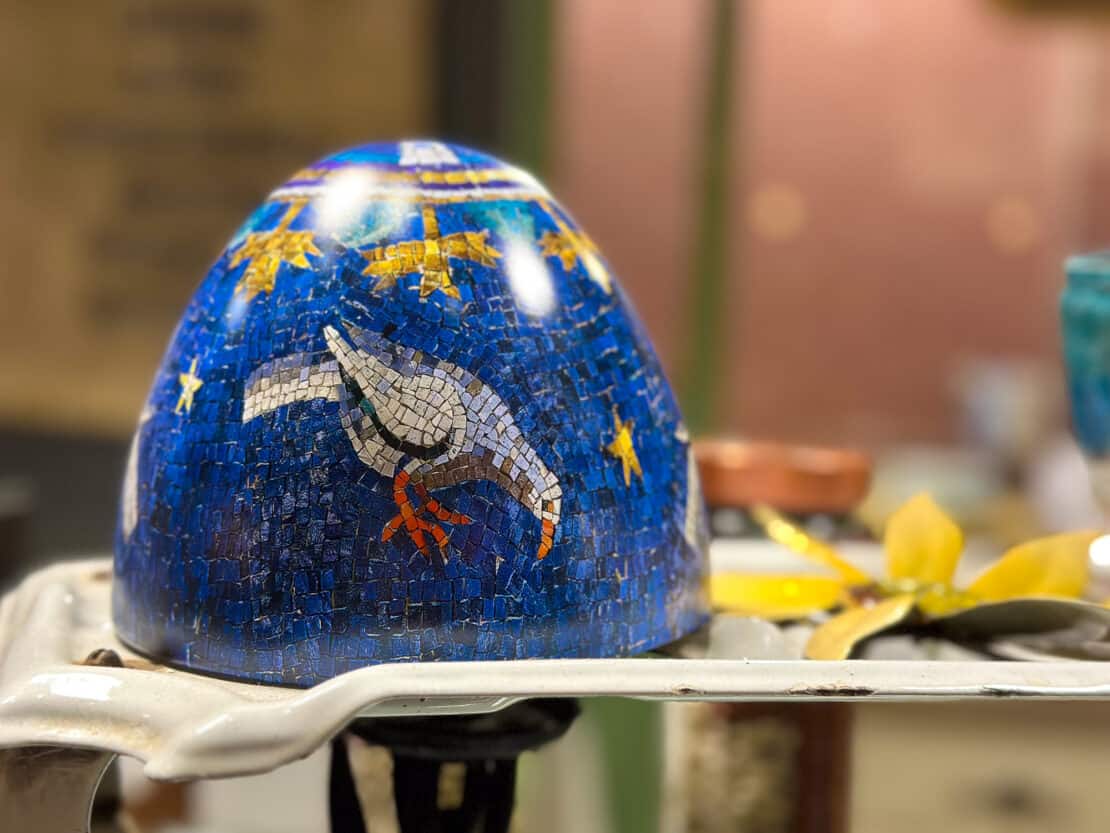
A Quick History of Ravenna
Ravenna’s mosaic heritage is steeped in history that dates back to the Roman Empire and beyond. The city’s rise to prominence began in the 5th and 6th centuries, when it served as the capital of the Western Roman Empire. During this golden era, Ravenna’s rulers and ecclesiastical figures commissioned magnificent mosaics that still shine brightly today.
What’s even more surprising is that all this took place in a relatively short time. Ravenna became the capital in 408 until the Western Roman Empire collapsed in 476. At that point, the Ostrogoths took over the kingdom before the Byzantine Empire reconquered the city in 540.
If you take a guided tour, you’ll hear a lot about this power struggle and how it shows up in the beautiful mosaics. But if names and dates turn you cold, you can just tune that out and appreciate the sight before you instead.
Here’s a recommended Ravenna mosaics guided tour from Get Your Guide. You can book online in advance and cancel up to 24 hours beforehand.
Must-Visit Mosaics in Ravenna
If you’re short on time, here are the big hitters:
- Basilica di San Vitale: A true masterpiece of Byzantine art, this Basilica stuns with its intricate mosaics that adorn the walls, arches, and dome. It is a testament to the exceptional craftsmanship of the time.
- Galla Placidia Mausoleum: Step into another world where the night sky mosaics and their skilful use of blue and gold tiles create an ethereal celestial panorama.
- Basilica di Sant’Apollinare Nuovo: This basilica is a symphony of colour, showcasing a 6th-century mosaic frieze that spans the entire length of the nave. The depiction of saints, martyrs, and Biblical scenes unfurls in spectacular fashion, with leopard print leggings to look out for among the pageantry.
- Baptistry of Neon: The Baptistry of Neon showcases an extraordinary mosaic of the Baptism of Christ, hidden within a rather plain building.
- Archiepiscopal Chapel: Tucked within the Archiepiscopal Palace, this chapel houses mosaics that narrate the story of Joseph from the Book of Genesis.
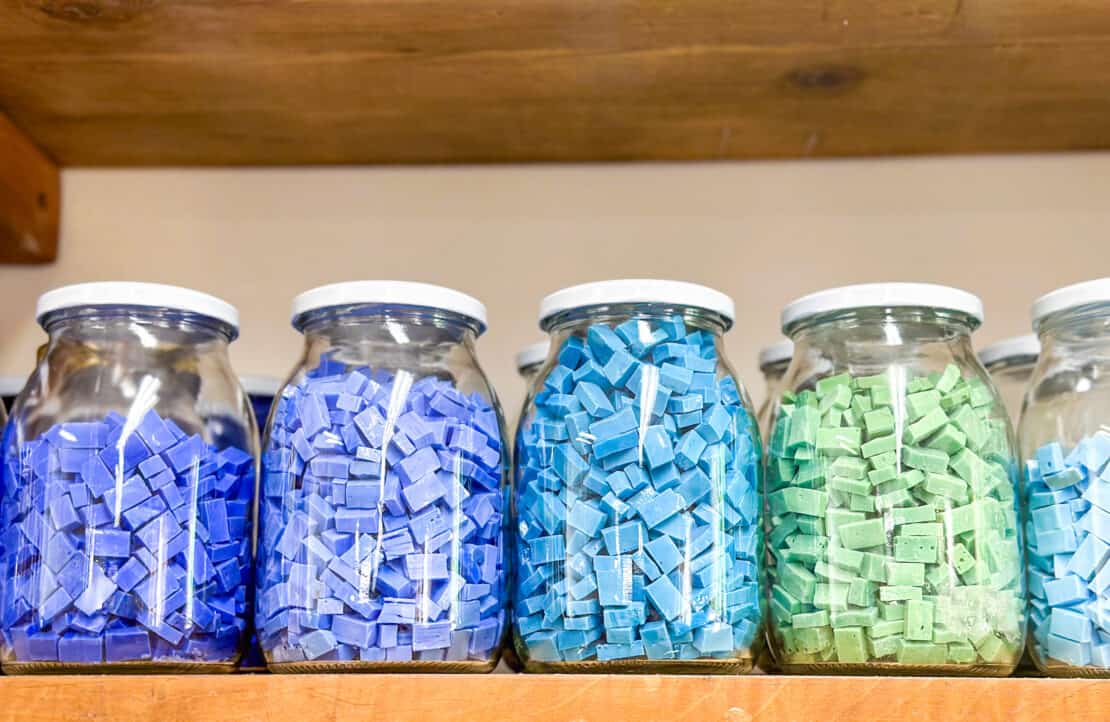
Learn how to make mosaics in Ravenna
One of the best things to do in Ravenna involves trying to make a mosaic yourself!
We headed to the Koko Mosaico workshop on Via di Roma, where you can take a course in just that. Run by a small and dedicated team, this studio hosts international students on long placements as well as running workshops that last just a few hours so that visitors passing through the city can learn more about the process.
Colour charts and glass mosaic pizzas line the shelves and it’s surprisingly satisfying to take a chisel and chip off your own mosaic-ready chunk.
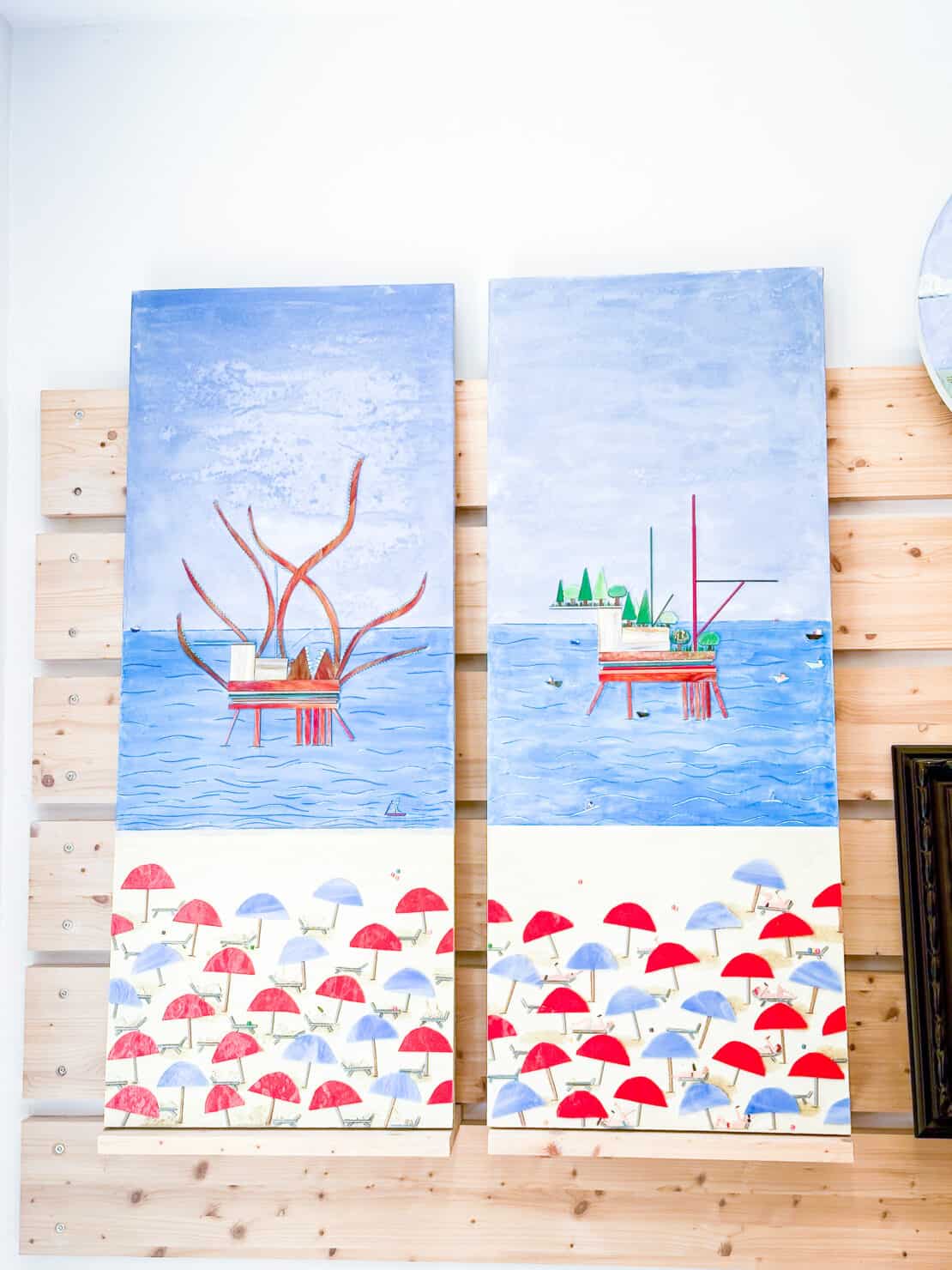
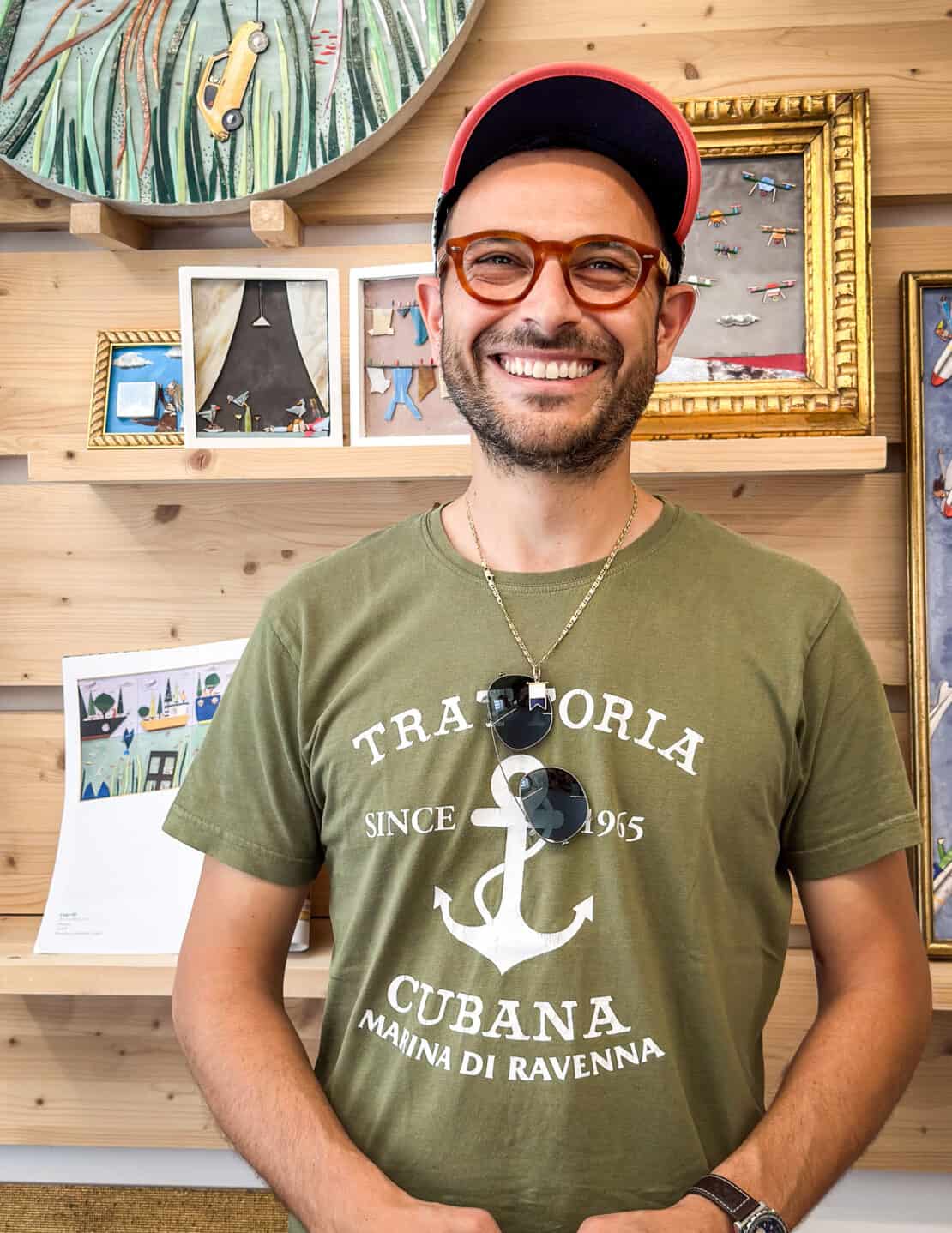
Luca Barberini: a modern mosaic artist
As it happens, we were lucky to catch Luca Barberini, a modern day mosaic artist, and chat to him about what guides his creative process.
We recognised his work from the main museum, the MAR, where we saw a mosaic of hundreds of faces in a crowd, a kind of Where’s Wally for mosaic art.
Barberini’s works pops with bright, sugary bubblegum colours, showing seaside days out from the nearby Adriatic coast.
However, on closer inspection, they’re really quite dark. Sunbathers are, quite literally, glued to their phones and sea monsters representing climate change threaten to pull boats of children down below the sea.
I’d highly recommend a visit to the workshop, even if you don’t have time to take a class. It’s so refreshing to see a different take on mosaics and to understand a little of the work that goes into them behind the scenes.
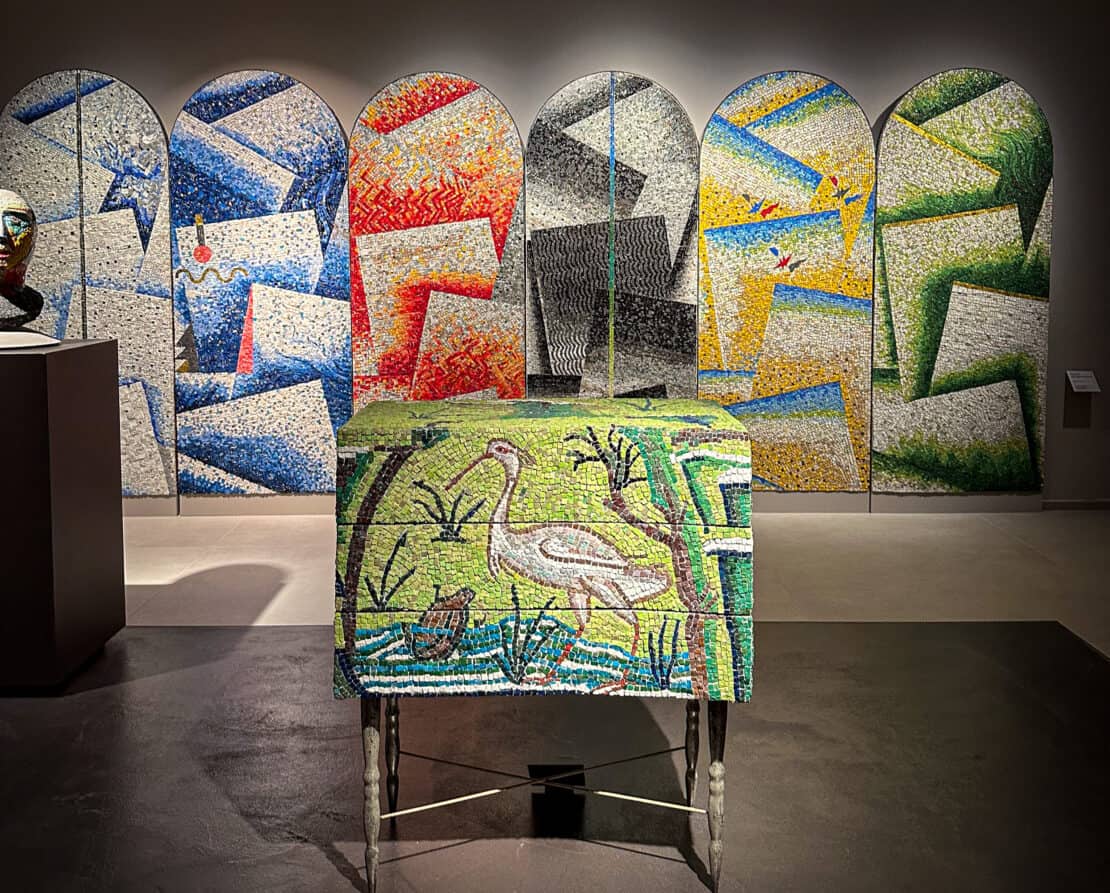
A word about modern mosaics and mosaic fatigue
After seeing all those mosaics, can you really handle seeing some more in a museum? Yes, yes you can!
The MAR Museum reinvents the idea of the mosaic through a series of thought provoking and eye poppingly bright works of art.
You’ll see famous paintings reproduced as mosaics, treasure chests decorated as mosaics and the whole idea of the mosaic reimagined through a collection of miniature books.
Just be careful where you sit down. Sometimes, what looks like a seat is actually a work of art. Oops…
Sinking Ravenna and the Basilica of San Francesco
Like Venice, the city of Ravenna in Italy is sinking.
These arches stand in the Basilica of San Francesco, looking through a 5th century sarcophagus to see a 10th century crypt where fish swim above the mosaics on the original floor.
The further twist in this fascinating place? It was once the funeral site of Dante, he of Dante’s Inferno fame. However, his body became the subject of a political power struggle and it was moved several times over.
His remains are now believed to be buried just outside.
How to see the Ravenna Mosaics
Now, you’ve got the gist of it, let’s move on to practicalities.
Map of the Ravenna Mosaics
How many UNESCO World Heritage Sites can you see in one day?
With only one day in Ravenna, it is possible to see all eight UNESCO World Heritage Sites but it is a bit of a squeeze. Five are centrally located and easy to walk between. The others need a little more planning.
Which are the eight UNESCO World Heritage Sites in Ravenna?
The sites are…
- The Basilica of San Vitale, a stunning example of Byzantine architecture.*
- The Mausoleum of Galla Placidia, a small but mighty masterpiece. The simple exterior belies the deep blue jewel-toned mosaics within.*
- The Basilica of Sant’Apollinare Nuovo. A church with mosaics over nearly every inch of its walls.
- The Archiepiscopal Museum. Ivory carvings, gold jewellery, and ancient manuscripts.
- The Neonian Baptistery – the ceiling shows the baptism of Christ.*
- Arian Baptistry – close to the Ravenna train station.
- Mausoleum of Theodoric – just outside Ravenna.
- Basilica of Sant’ Apollinare in Classe – 8 km from Ravenna
I’ve marked the ones that you can easily see in one afternoon with a *. They are all in the city centre – and in this instagram Ravenna mosaic video!
Let’s look at some of them in more depth.
Ravenna Mosaics in More Depth
Let’s talk about the big hitters…
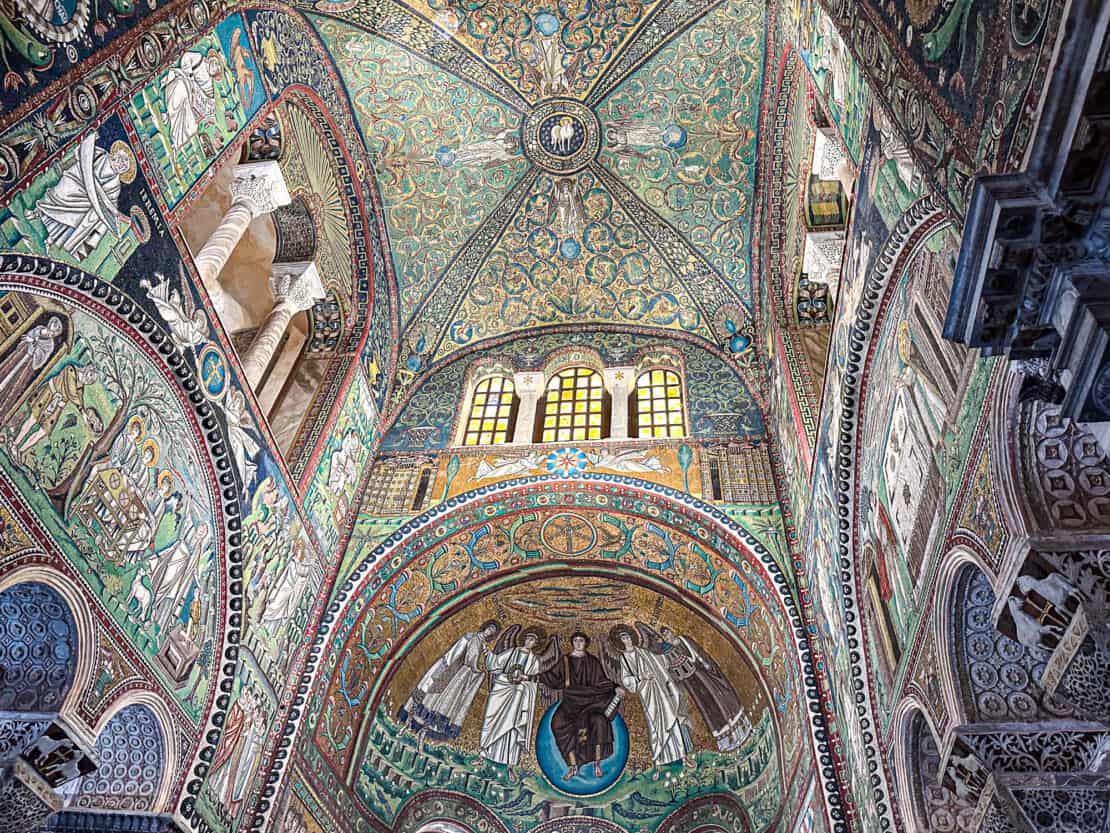
Basilica di San Vitale
This is the big one. This magnificent basilica combines Byzantine and Roman architectural styles, creating a captivating structure that mixes east and west. The construction of the basilica began in 527 AD during the reign of Emperor Justinian I and was completed in 548 AD. Its octagonal shape and exquisite mosaics make it stand out among other religious buildings of the time.
The interior of the basilica is particularly impressive, showcasing the finest examples of Byzantine art. The mosaics depict various biblical scenes and figures such as Emperor Justinian and Empress Theodora, illustrating the close relationship between religion and politics during that era.
The grand dome and ornate columns add to the atmosphere of grandeur as you crane your neck up to see the Mystic Lamb on the ceiling.
These photos really don’t do it justice. It is astonishing.
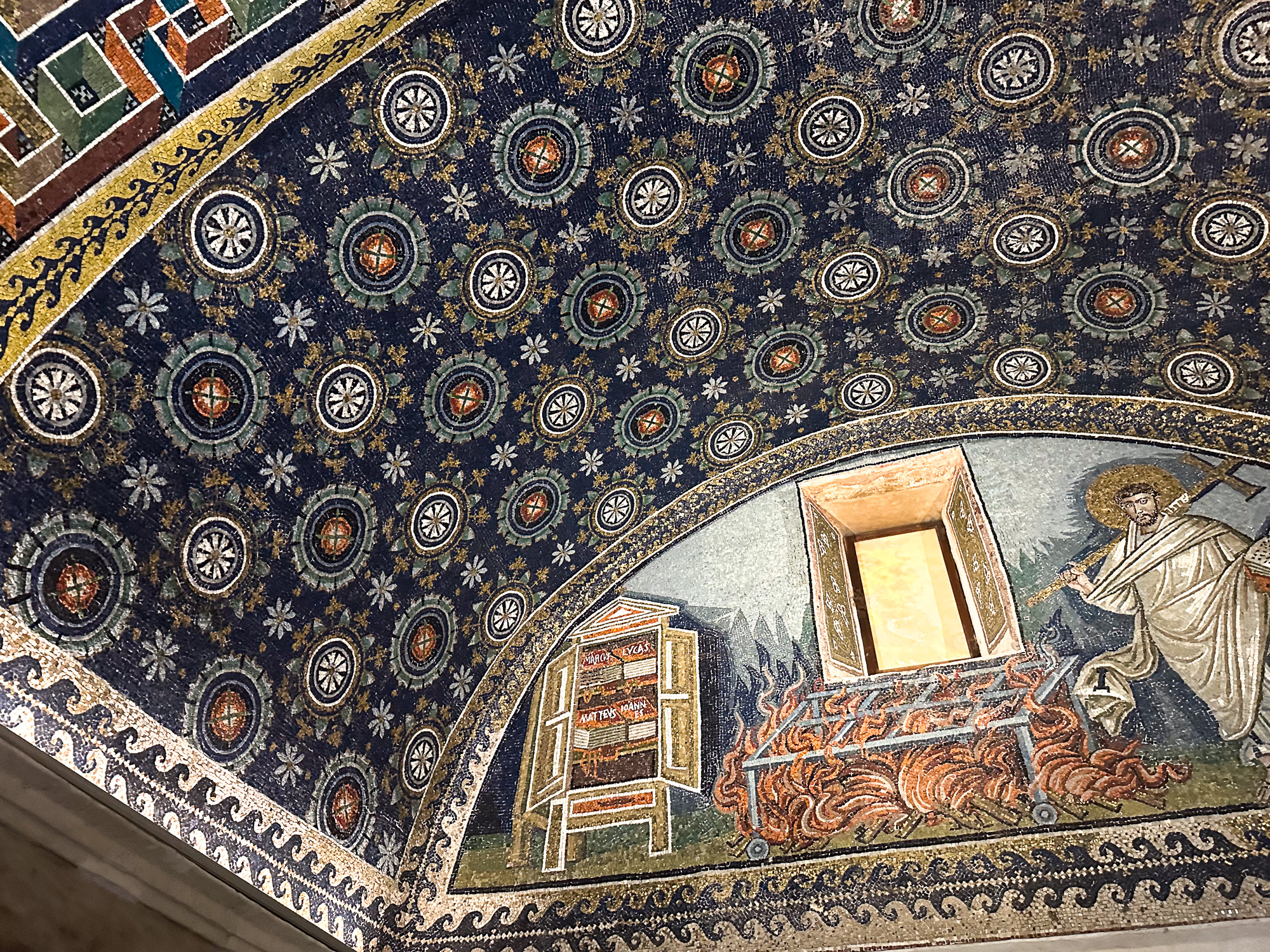
Galla Placidia Mausoleum
Though she is small, she is mighty. The Galla Placidia Mausoleum may not look too spectacular from the outside but inside is the kind of artwork that will stop you in your tracks time and again.
It is named after Galla Placidia, a noblewoman and member of the imperial family of the Western Roman Empire , a woman who lived a very complicated life. The mausoleum features a simple exterior adorned with reliefs and mosaics, while its interior showcases intricate Byzantine mosaics that depict various scenes from early Christianity and a starry overhead sky.
Despite its age, the structure has been exceptionally preserved. Stepping into the Mausoleum feels like a journey back in time, as if the artists had just that second finished and headed off for lunch.
Who was Galla Placidia? Galla Placidia, a prominent figure in the late Roman Empire, led a remarkable life intertwined with political alliances and dynastic ties. Born in 388 AD, she was the daughter of Emperor Theodosius I and his second wife Galla, and sister to emperors Arcadius and Honorius. Her life took a significant turn when she married Ataulf, a Visigothic king, in 414 AD. This marriage aimed to solidify the relationship between the Roman and Visigothic realms, though Ataulf’s subsequent death led to Galla Placidia being captured by his successor, Sigeric. Following her eventual release, she returned to Rome, where her brother Honorius forced her into another strategic marriage, this time with the powerful general Constantius III.
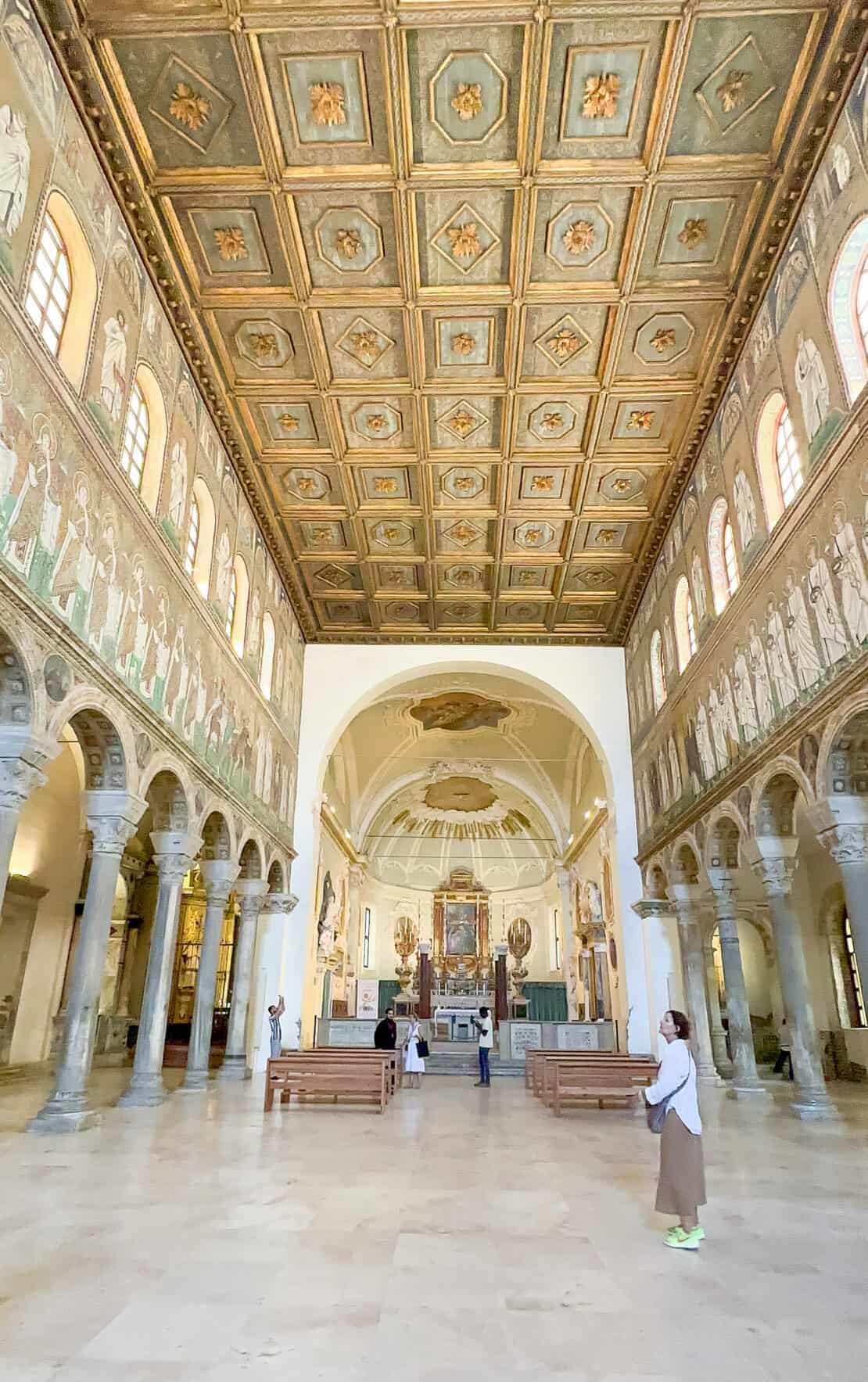
The Basilica di Sant’Apollinare Nuovo
Also part of the Early Christian Monuments of Ravenna UNESCO World Heritage Sites, the Basilica of Sant’Apollinare Nuovo is a magnificent church.
No, really, even for those rather jaded after visiting too many churches in Europe, this one is a staggering work of beauty and it also holds the record of being the largest monument decorated with mosaics.
The basilica was built in the 6th century by the Ostrogothic King Theodoric, who wanted to show benevolence. As a result, mosaics depict the town hall in between the two rival religious temples.
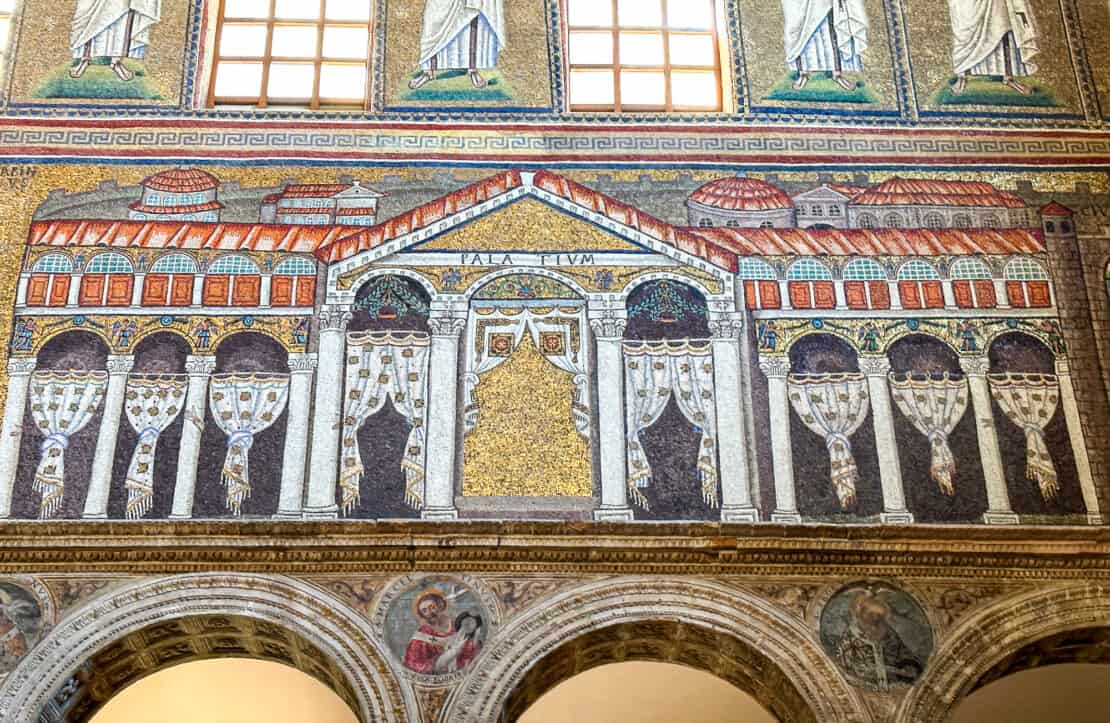
Following the arrival of the Byzantines, the church was reconsecrated and the Pope suggested that the mosaics should be blackened as their shine was distracting those who worshipped within.
It seems the artists of the time found a compromise, covering the Goths with mosaic curtains, leaving only tell-tale scenes of hands peeping out from behind the columns.
Inside tip: look out for the 3 Wise Men attending the first nativity dressed in leopard leggings and miniskirts. Standard 5th century attire, apparently.
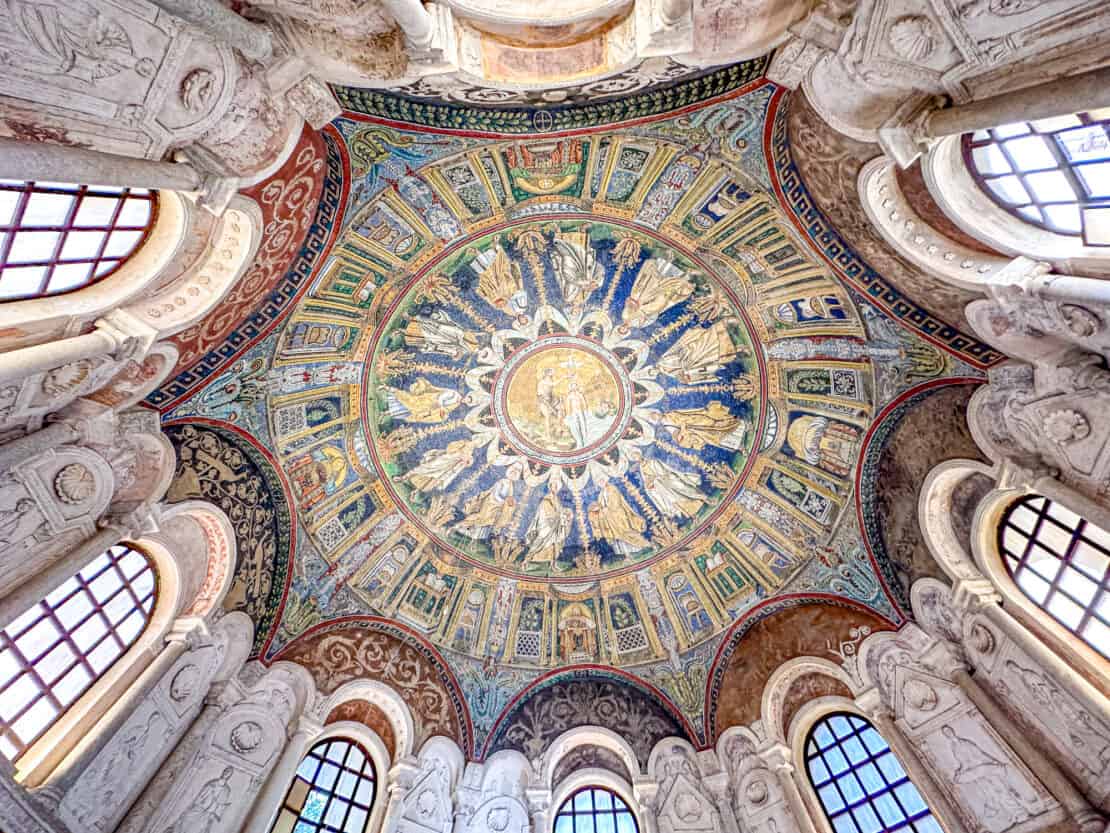
The Baptistry of Neon
Again, while looking rather plain from the outside, the Baptistry of Neon is astonishingly beautiful within. As the name suggests, it’s primarily used for baptisms and features a mosaic which depicts the baptism of Jesus in the River Jordan by John the Baptist.
It’s octagonal, a feature of early Christian baptistries, with one side for each day of the week and one to symbolise the Day of the Resurrection and Eternal Life.
I really can’t stress this enough, don’t let this long list of Early Christian mosaics put you off. This structure is stunning.
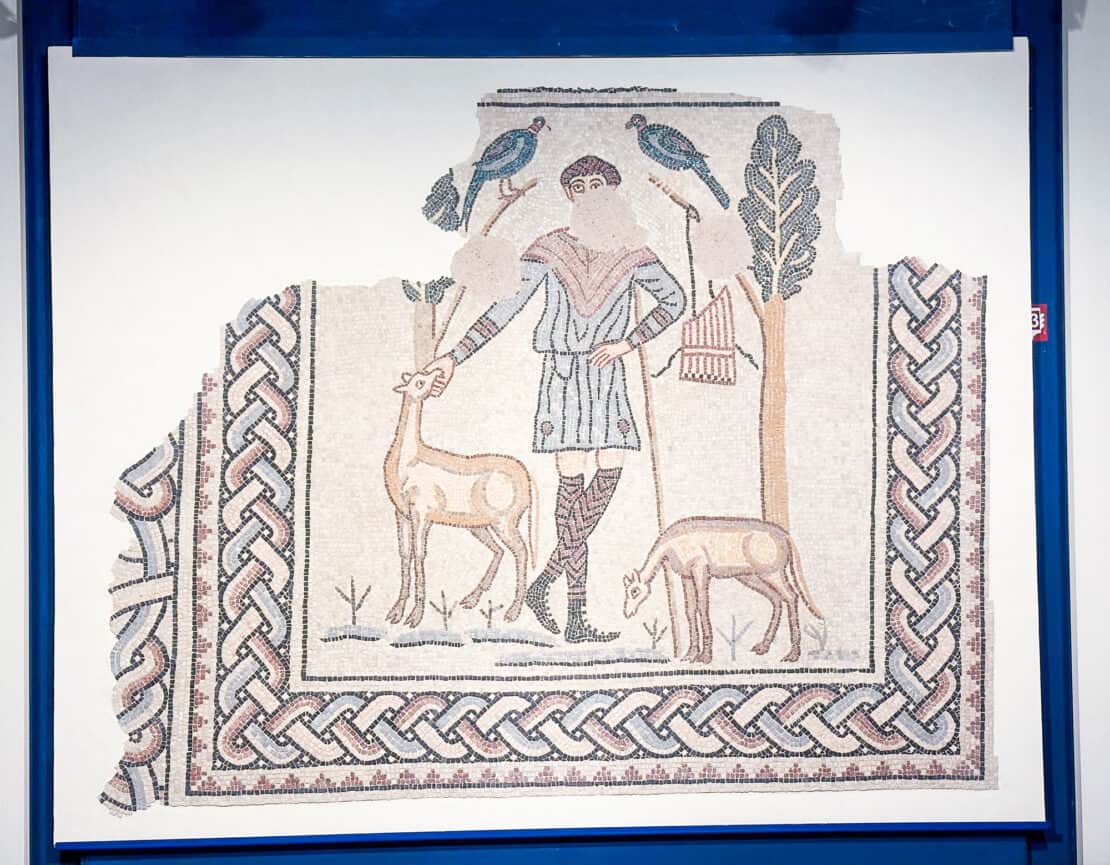
Domus of the Stone Carpets
The Domus of the Stone Carpets also offers insights into the past, with older mosaics made in a distinctly different style. The meticulously crafted mosaic floors or “stone carpets” have earthy tones and a lot of white.
Look out for the resplendent peacock, as well as scenes showcasing elegantly poised deer and exotic flora. Then there’s the big mystery on the wall: spring, autumn and winter, but whatever happened to summer?
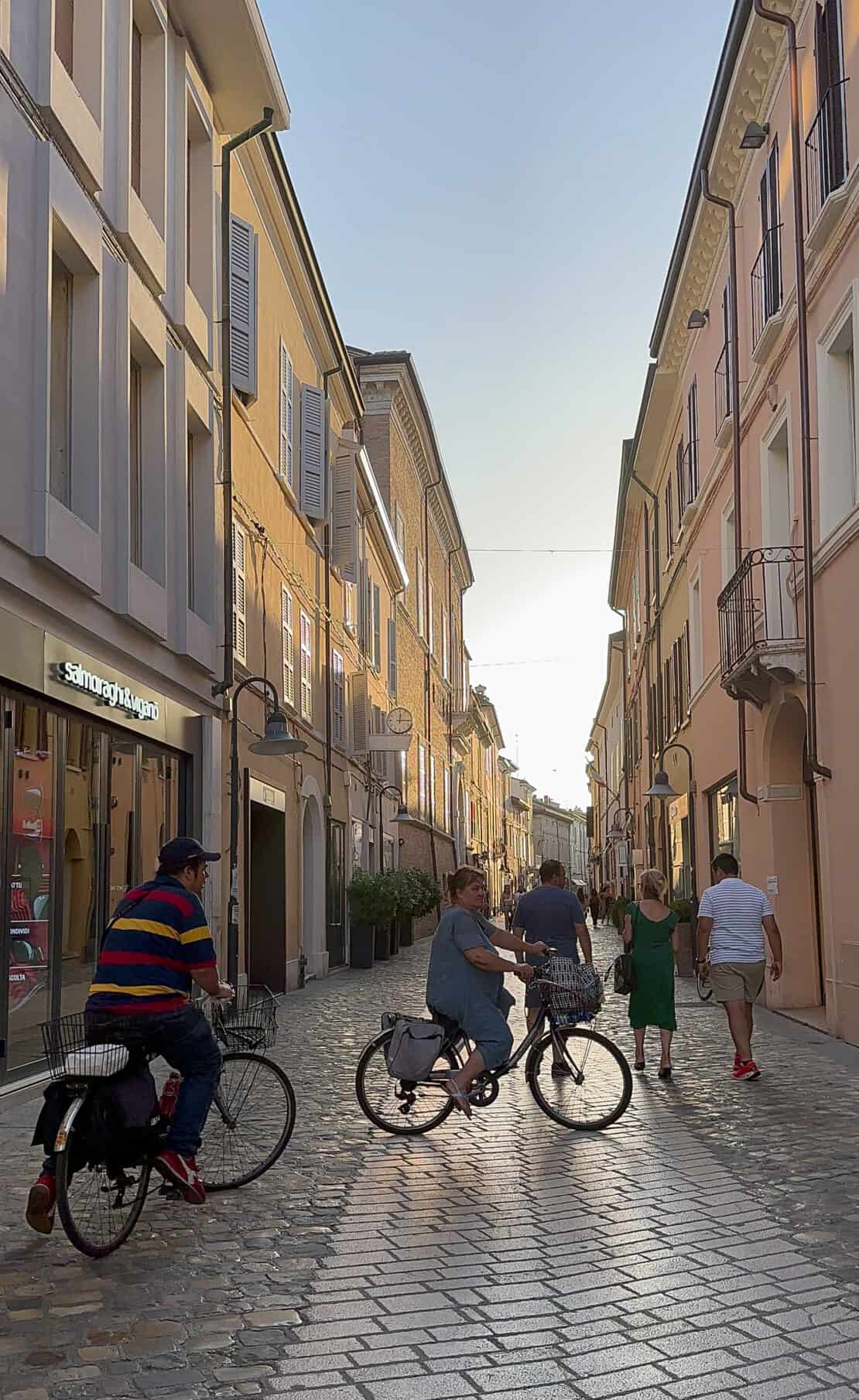
Practical Information
How to get to Ravenna
Ravenna is well-connected by train, making it easily accessible from major Italian cities such as Bologna, Florence and Venice.
From London to Ravenna:
If you’re departing from London, the most convenient option is to catch a flight from London Heathrow Airport (LHR) or London Gatwick Airport (LGW) to Bologna Guglielmo Marconi Airport (BLQ). Numerous airlines operate this route, and flights take approximately 2.5 to 3 hours. From Bologna, you can easily reach Ravenna by train, which takes around 1 hour. Trains are frequent and provide a comfortable journey through the scenic Italian countryside.
From the US to Ravenna:
Traveling to Ravenna from the US typically involves a connecting flight. You can choose to fly from major US airports like New York’s John F. Kennedy International Airport (JFK) or Los Angeles International Airport (LAX) to Bologna Guglielmo Marconi Airport (BLQ).
Flight durations vary based on departure city and layovers, but they generally range from 10 to 12 hours. After arriving in Bologna, take a train to Ravenna, which usually takes around 1 hour. The combination of flights and train travel ensures a seamless journey to your destination.
Please note that flight times and availability may vary based on the chosen airlines, layovers, and schedules. It’s recommended to check with airlines and travel platforms for the most up-to-date information on flights and train connections before making your travel arrangements.
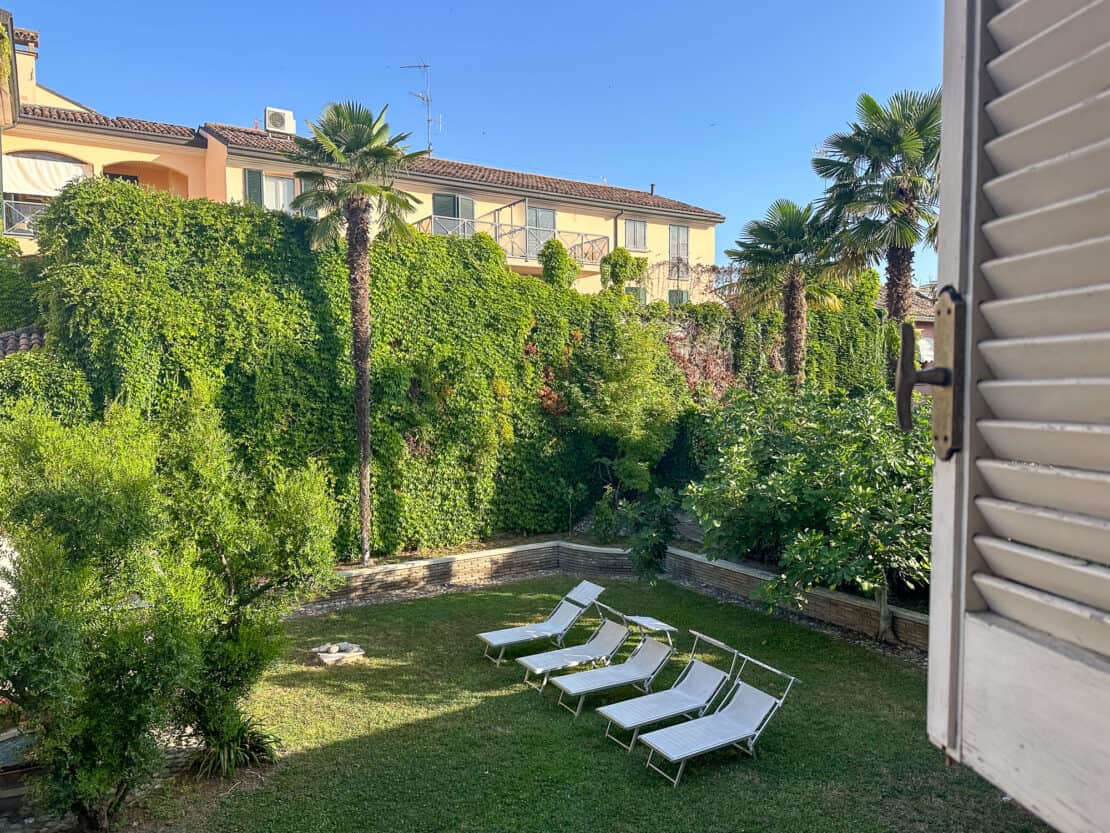
Where to stay in Ravenna
The city offers a range of accommodations to suit every traveler’s preferences, from charming boutique hotels to cozy bed and breakfasts.
Here are some recommended places to stay in Ravenna:
Palazzo Bezzi Hotel:
- A charming boutique hotel located in the heart of Ravenna.
- Combines modern elegance with historical elements, offering comfortable and stylish rooms.
- Rooftop terrace with panoramic views of the city, making it an ideal spot to unwind after a day of exploring.
Book a room at the Palazzo Bezzi Hotel here.
Hotel Sant Andrea:
- Reasonable rooms in a gorgeous converted grand house with a garden.
- Lacto-free friendly!
Find the latest rates for the Hotel Sant Andrea here.
Hotel Classensis:
- Situated in a quiet neighbourhood, this hotel offers a tranquil retreat.
- Elegant rooms, each uniquely designed and equipped with modern comforts.
- Lovely garden area and outdoor pool.
Book your stay at the Hotel Classensis here.
Mosaico Hotel:
- Stylish rooms with mosaic-inspired decor.
- Central location, making it convenient to explore Ravenna’s attractions on foot.
Check out the latest rates at the Mosaico Hotel here.
Ai Giardini di San Vitale:
- Set within a restored historic building.
- Cozy and individually decorated rooms based on local influences.
- Garden for breakfast or afternoon reading.
Make a booking at Ai Giardini di San Vitale here.
Remember, as ever, to book in advance if you can, especially during peak travel season.
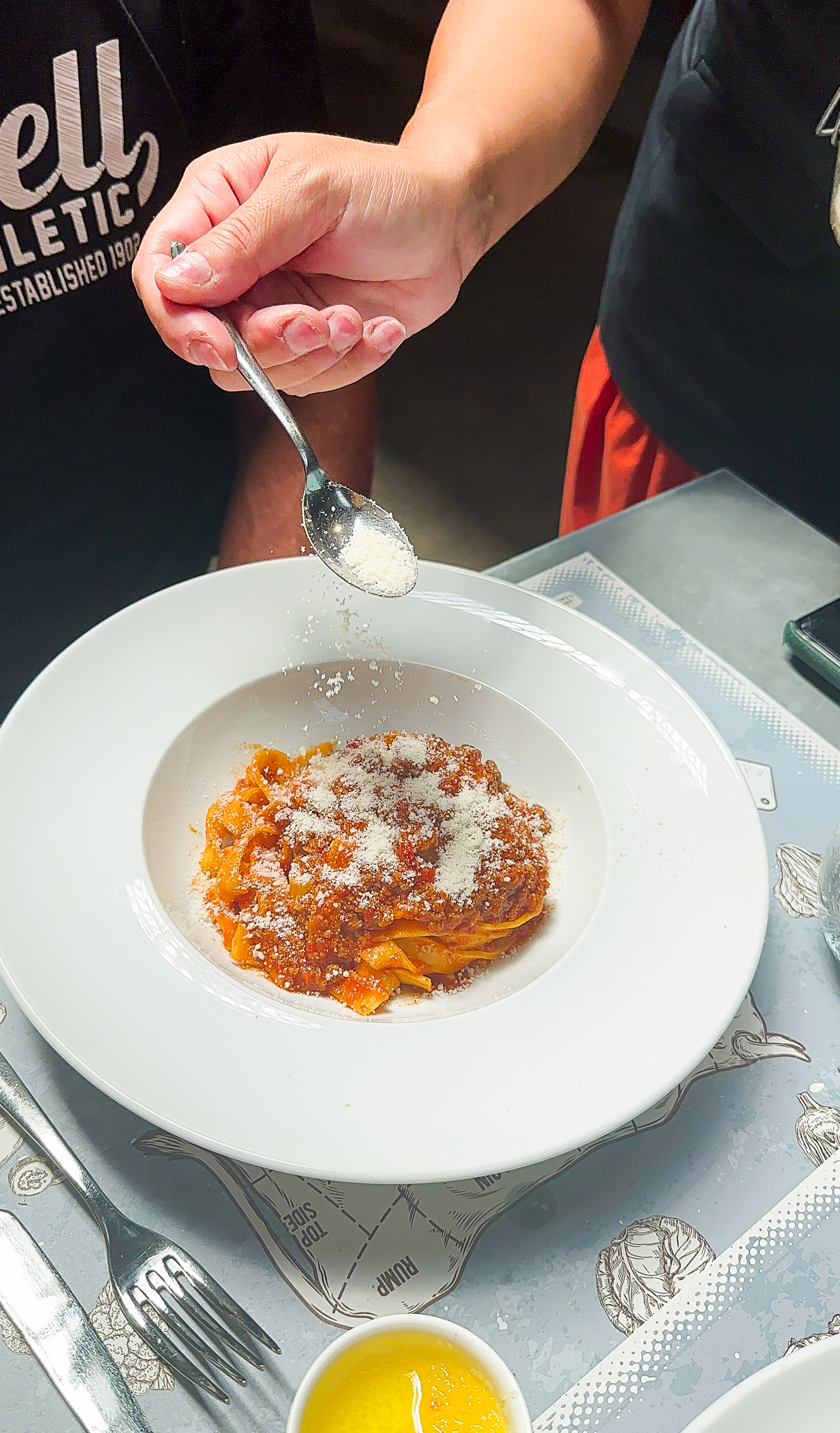
Where to eat in Ravenna
Don’t miss the opportunity to savour local delicacies, including piadina (a traditional flatbread), seafood, and exquisite Romagna wines. It’s also fun to walk through and pick up lunch at the Mercato Coperto, the new covered market in the centre of town.
Osteria Passatelli dal 1962:
- A traditional osteria known for its warm ambiance and classic Romagnolo cuisine.
- Don’t miss the Passatelli, a local pasta specialty made from breadcrumbs, eggs, and cheese, served in a rich broth.
Trattoria al Gallo:
- A family-run trattoria that offers authentic and hearty Emilian dishes.
- Try the Tagliatelle al Ragù, a comforting plate of fresh pasta served with a flavorful slow-cooked meat sauce.
Cantina di David:
- A charming wine bar and restaurant that celebrates the region’s culinary traditions.
- Sample the Piadina, a thin Italian flatbread stuffed with various fillings like cured meats, cheeses, and fresh vegetables.
Ca’ de Vèn:
- A rustic trattoria with a focus on locally sourced ingredients and traditional recipes.
- Don’t miss Cappelletti, small pasta dumplings filled with a mix of meats and served in a savoury broth or sauce.
Ristorante Piattoforte:
- An elegant restaurant offering a fusion of local and innovative cuisine.
- Indulge in the Zuppa di Pesce, a delightful seafood stew that captures the essence of Ravenna’s coastal location.
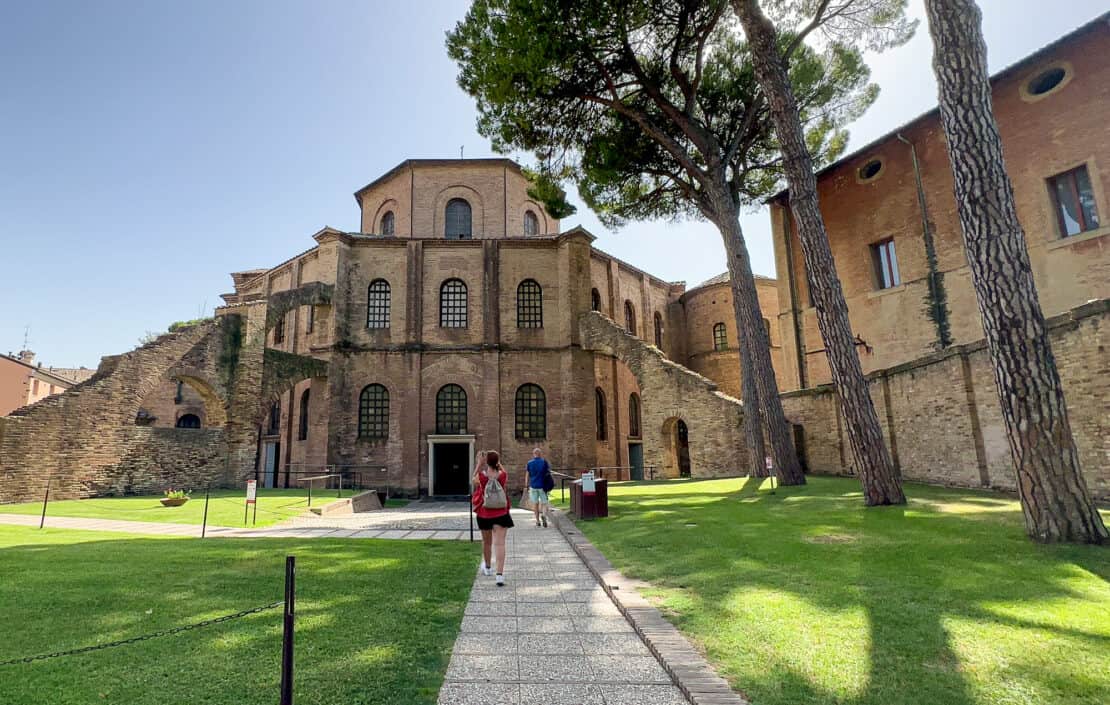
When to visit the Ravenna Mosaics
The best time to visit the Ravenna mosaics is during the spring and autumn seasons, which span from April to June and September to October. During these months, the weather is pleasant, with mild temperatures and fewer crowds compared to the peak summer months.
This allows you to explore the mosaics and historical sites at a more relaxed pace, without the sweltering heat and bustling tourist crowds.
But with all of that said, there really is no bad time to visit Ravenna.
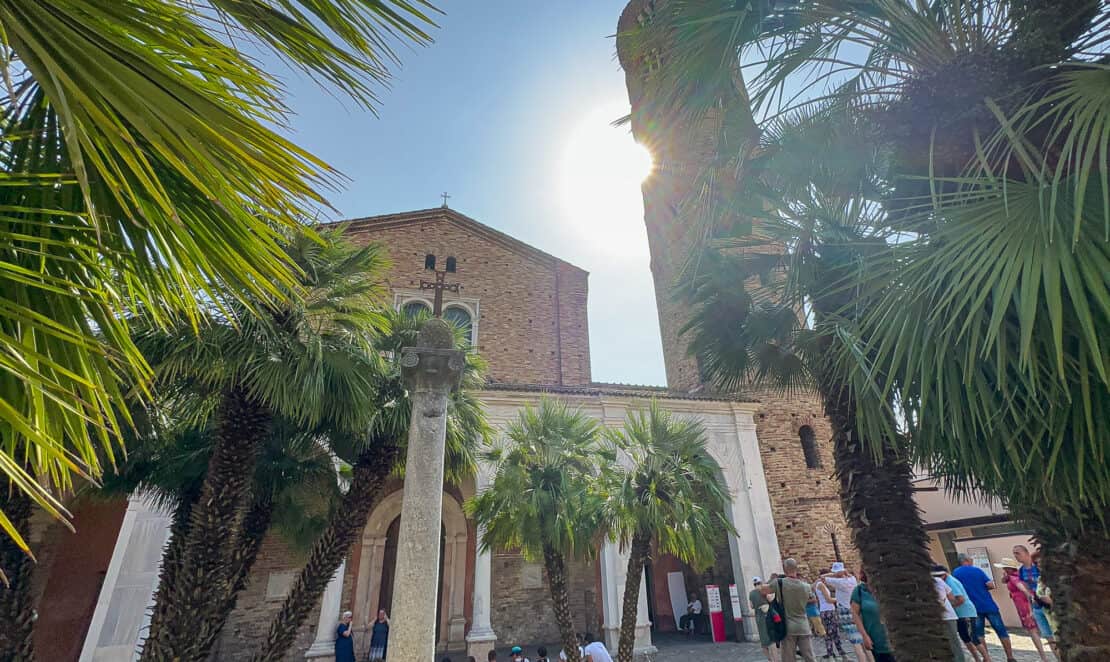
The Best of the Ravenna Mosaics in One Day: A Sample Itinerary
This is an intense one day itinerary to see most of the mosaics listed as UNESCO World Heritage Sites. Honestly, I’d recommend you relax the pace a little and make the most of the city of Ravenna.
Ideally, spend two days and take in the Dante sights and the modern mosaic art. Heck, even make a mosaic yourself! However, if you’re on a UNESCO quest, here’s how to see most of them in just one day.
You can also find a really helpful map of the Ravenna mosaics here.
Morning:
9:00 AM: Beat the crowds and visit the Basilica di San Vitale as it opens.
- Marvel at the exquisite mosaics depicting Emperor Justinian and Empress Theodora.
- Spend about 1 hour exploring the intricate details of the mosaics.
9:45 AM: Head next door to the Galla Placidia Mausoleum.
- Admire the enchanting night sky mosaics and the serene atmosphere.
- Allocate around 30 minutes for your visit.
Mid-morning:
- 10:30 AM: Walk to the Basilica di Sant’Apollinare Nuovo.
- Take in the sprawling mosaic frieze along the nave, portraying saints and Biblical scenes.
- Dedicate about 1 hour for a comprehensive exploration.
Lunch:
- 12:00 PM: Enjoy a leisurely Italian lunch at a local trattoria.
- Indulge in regional delicacies, perhaps trying the famous Tagliatelle al Ragù.
Afternoon:
1:30 PM: Head to the Baptistry of Neon.
- Observe the vivid mosaic of the Baptism of Christ and its spiritual significance.
- Allocate around 30 minutes for your visit.
2:00 PM: Proceed to the Archiepiscopal Chapel.
- Immerse yourself in the mosaic narrative of Joseph from the Book of Genesis.
- Spend about 45 minutes appreciating the intricate artwork.
Late Afternoon:
- 3:00 PM: Wrap up your UNESCO tour with a visit to the Mausoleum of Theodoric.
- Admire the simplicity and grandeur of this ancient monument’s architecture.
- Allocate about 30 minutes for your visit. However, bear in mind you will likely need a taxi or other transport to reach it as it is quite a way out of town.
Evening:
- 6:00 PM: If time allows, take a stroll through Ravenna’s charming streets and soak in the local atmosphere.
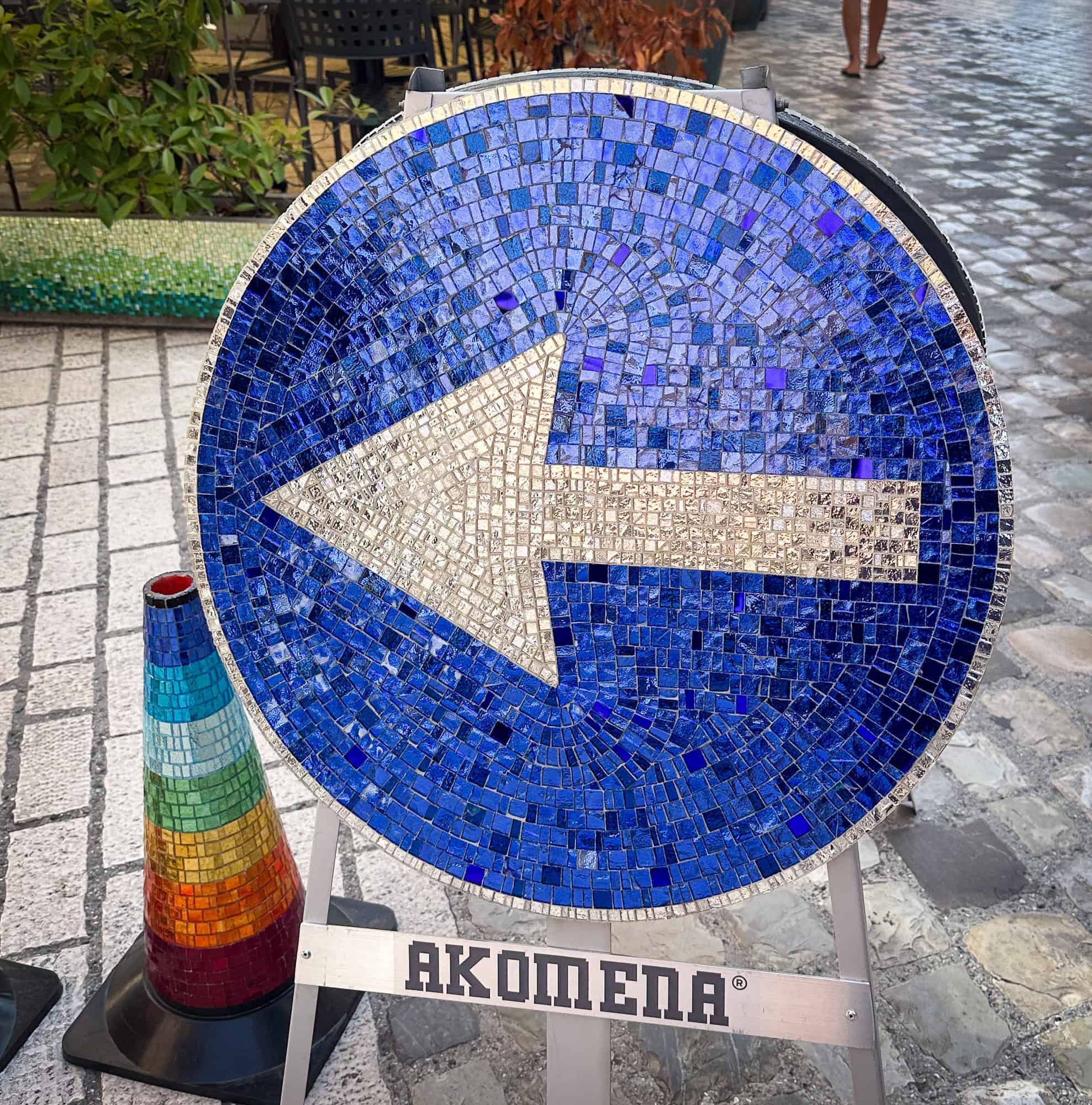
FAQs about visiting the mosaics in Ravenna
Questions about your trip to Ravenna? Let’s see if we can help.
How much does it cost to visit the Ravenna mosaics?
Basilica di San Vitale: The entrance fee is usually around €10 to €12 for adults. Reduced fees are often available for students, seniors, and groups.
Galla Placidia Mausoleum: The entrance fee is typically around €5 to €6 for adults, with discounts for students and seniors.
Baptistry of Neon: The entrance fee is usually around €5 to €6 for adults, with discounts for students and seniors.
Archiepiscopal Chapel: The entrance fee is generally around €2 to €3 for adults.
These prices are approximate and can vary depending on factors such as age, nationality, and any special exhibitions or guided tours that might be included in the ticket. Additionally, some sites might offer combined tickets that provide access to multiple attractions at a slightly reduced cost.
For the most accurate and up-to-date information on ticket prices and any available discounts, visit the official websites of the individual sites or contact the tourist information centre in Ravenna before your trip.
Do You Need a Tour to Visit the Ravenna Mosaics?
No, you do not necessarily need a tour to visit the Ravenna mosaics. The sites with mosaics, such as the Basilica di San Vitale, Galla Placidia Mausoleum, Basilica di Sant’Apollinare Nuovo, Baptistry of Neon, and the Archiepiscopal Chapel, are often open to independent visitors who can explore the mosaics on their own.
However, whether or not you choose to take a tour depends on your preferences and the level of insight you want during your visit.
Advantages of Taking a Tour:
Guided Information: Joining a guided tour can provide you with in-depth historical and artistic information about the mosaics, their context, and their significance. A knowledgeable guide can help you understand the intricate details and stories behind the artwork.
Contextual Understanding: Guides can offer a deeper understanding of the historical and cultural context in which the mosaics were created, enhancing your overall experience.
Efficiency: Tours can help you make the most of your time by providing a structured itinerary and ensuring you don’t miss any important details.
Interactive Experience: Guided tours often involve interactive discussions and the opportunity to ask questions, creating a more engaging experience.
Here’s a recommended Ravenna mosaics guided tour from Get Your Guide. You can book online in advance and cancel up to 24 hours beforehand.
Advantages of Exploring Independently:
Flexibility: Visiting the mosaics on your own allows you to set your own pace and spend more time at sites that particularly interest you.
Personal Exploration: You can take your time to admire the mosaics at your leisure and absorb the beauty of the artwork without any time constraints.
Cost Savings: Independent visits generally cost less compared to guided tours, which often involve additional fees for the guide’s services.
Ultimately, the decision depends on your travel style, budget, and preferences. If you’re comfortable researching the history of the mosaics and their significance beforehand, exploring independently can be rewarding. On the other hand, if you desire a deeper understanding and want to benefit from expert insights, joining a guided tour can be a valuable choice.
Is a day trip long enough to see the Ravenna mosaics?
Yes, but it’s a rush. Check out the one day Ravenna itinerary higher up to see what you can comfortable see within a day.
Do you need a reservation to visit the mosaics of Ravenna?
Reservations are generally not required to visit the mosaics in Ravenna. Most of the sites, such as the Basilica di San Vitale, Galla Placidia Mausoleum, Basilica di Sant’Apollinare Nuovo, Baptistry of Neon, and the Archiepiscopal Chapel, allow visitors to purchase tickets on-site without prior reservation.
However, it’s always a good idea to check the latest information and any updates regarding reservation requirements before your visit. Some factors that might influence this include special events, exhibitions, and changes in visitor policies.
Where can you buy tickets for the Ravenna mosaics?
Here are some general guidelines:
On-Site Ticket Booths: Most of the major mosaic sites in Ravenna have ticket booths or counters at their entrances where you can purchase tickets directly. These sites include the Basilica di San Vitale, Galla Placidia Mausoleum, Basilica di Sant’Apollinare Nuovo, Baptistry of Neon, and the Archiepiscopal Chapel.
Combined Tickets: Some sites offer combined tickets that provide access to multiple attractions at a slightly reduced cost. For example, you might find a ticket that includes entry to multiple mosaics and historical sites.
Tourist Information Centres: If you’re looking for information on ticket options or wish to purchase tickets in advance, you can visit the local tourist information centres in Ravenna. They can provide you with details about various ticket packages and help you plan your visit.
Online Ticketing: While reservations are generally not required, some sites offer online ticketing options to streamline the entry process, especially during busy periods. Check the official websites of the individual mosaic sites for any online ticketing options that might be available here.
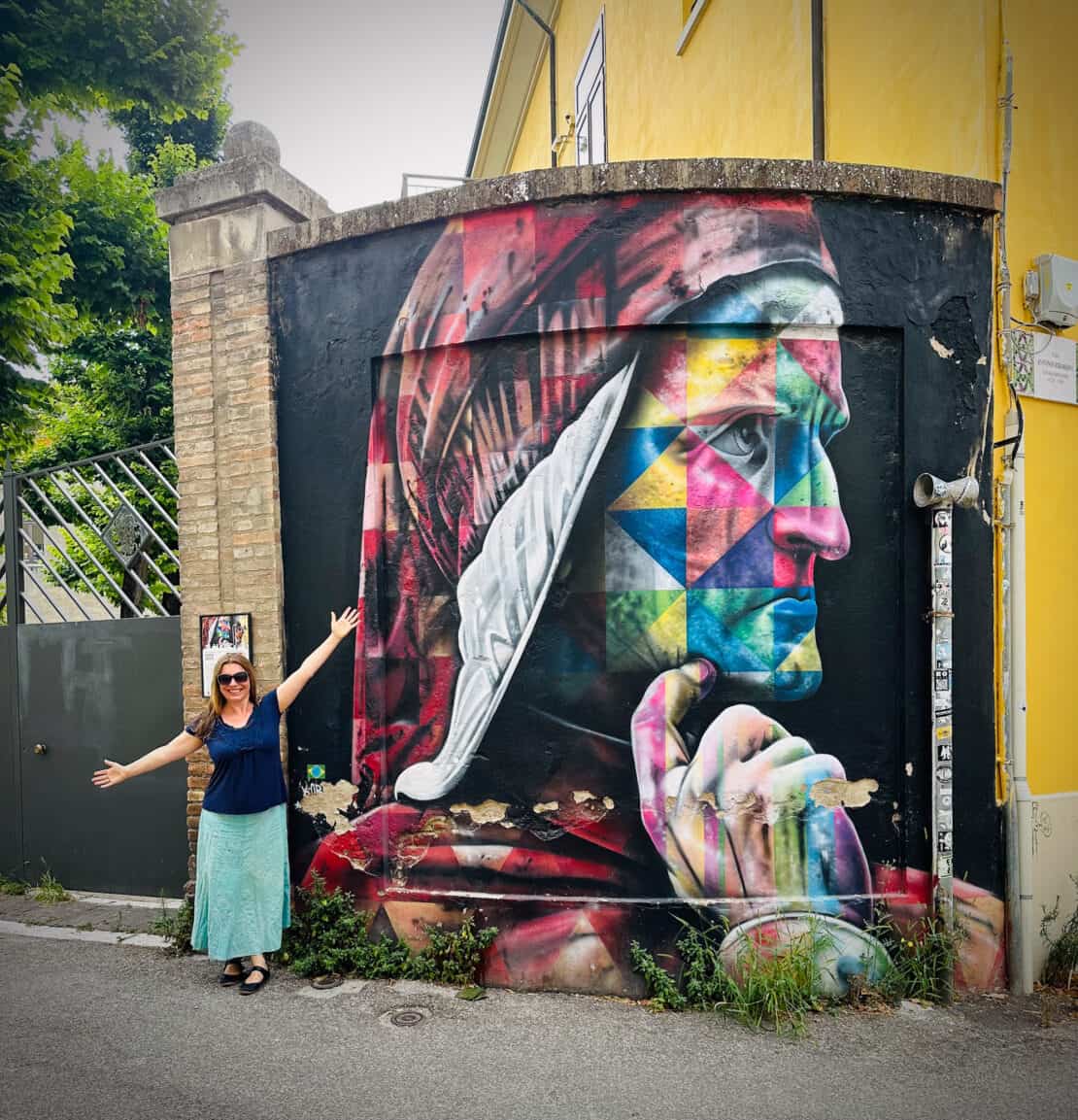
There’s more to Ravenna than just mosaics
When you’re visiting Ravenna, you have to see at least some of these world class early Christian and Byzantine mosaics. They are what Ravenna is famous for after all!
However, the city is also a great place for eating, drinking, and people watching, not to mention a handy base for excursions along the coast to see Rimini, for example. Watch this space for more on how to make the most of this gorgeous part of Italy.
More on how to plan a trip to Italy
- The Italian landmarks for your Italy bucket list
- How to get off the beaten path in Italy with 101 hidden gems
- What to buy in Italy: your guide to Italian souvenirs
- The best Italian themed gifts for people who love Italy
- The best sparkling Italian wines for the end of summer
- The surprise you’ll find in Comacchio
- How to make a real ragu: the traditional Italian dish you can make at home
Find more on our European travel destinations page.

